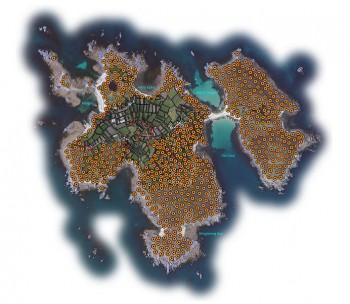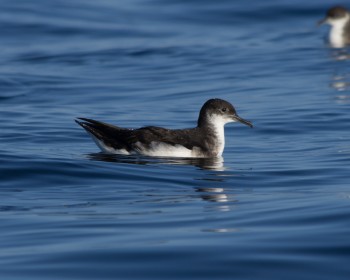The ground-baiting campaign to remove Norway or Brown Rats Rattus norvegicus from the inhabited islands of St. Agnes and Gugh (connected by a tombolo) in the United Kingdom’s Isles of Scilly appears to have met with success. Rat removal in the Scilly Isles will help protect small populations of Manx Shearwaters Puffinus puffinus and European Storm Petrels Hydrobates pelagicus that have been reported breeding on both islands.

The bait station sites on St Agnes (left) and Gugh (right) that led to the eradication of the rats
The latest issue (No. 3 of March 2013) of the Isles of Scilly Seabird Recovery Project’s newsletter The Shearwater reports “[w]e are delighted to update you to say there has been no sign of rats on St Agnes and Gugh for the last 16 weeks at the time of writing this newsletter.” However, a formal announcement that the rats are definitely gone will only follow the accepted two-year rat-free period in 2016.
The rat-removal phase of the eradication project was undertaken by Elizabeth (Biz) Bell and colleagues of New Zealand’s Wildlife Management International Ltd (WMIL), which previously undertook the feasibility study into rat removal from the Isles of Scilly. They used 1036 commercial lockable and tube stations carrying poison bait distributed over both islands. These stations alomg with "all the pieces of wire, flagging tape [and] bamboo cane" have now been removed.
Plans are now in place to ensure that biosecurity protocols are adequate to ensure rats do not reinvade the islands, with training workshops being run for the islands’ inhabitants. As part of post-eradication monitoring, permanent stations have been set up around the coasts of St Agnes and Gugh. They house pieces of chocolate wax known to be attractive to rats.

Manx Shearwater at sea
Photograph by Nathan Fletcher
The newsletter also reports that the first “Manxies” have been sighted offshore on 21 March as the new breeding season approaches; hopefully one without the risk of breeding attempts being depredated by rodents.
The Isles of Scilly consist of five inhabited islands and numerous other small rocky islets off Cornwall in the south of England. The project has been run by a partnership of organisations: RSPB, Isles of Scilly Wildlife Trust, Natural England, Duchy of Cornwall and the Isles of Scilly Area of Outstanding Natural Beauty.
For the European Storm Petrel, the Isles of Scilly represent the sole breeding site in England, with 1398 pairs. The islands are also one of only two breeding sites for the Manx Shearwater in England with 171 pairs; the other being the island of Lundy in the Bristol Channel.
Click here for earlier reports in ACAP Latest News on the eradication attempt.
Selected Literature:
Bell, E. 2011. Isles of Scilly Seabird Recovery Project: Summary Report: Improving rodent control on uninhabited islands, assessment of the feasibility of rat removal across the Isles of Scilly Archipelago and feasibility of rat removal from St Agnes and Gugh. Blenheim: Wildlife Management International Ltd. 40 pp.
Brooke, M. de L. 1990. The Manx Shearwater. London: T & AD Poyser. 246 pp.
Lock, L., Brown, A., Webber, J., Mawer, D. & St. Pierre, P. 2009. Isles of Scilly Seabird Conservation Strategy 2009-2013.
Mitchell, P.I., Newton, S.F., Ratcliffe, N. & Dunn, T.E. 2004. Seabird Populations of Britain and Ireland. Results of the Seabird 2000 Census (1998-2002). London: Christopher Helm. 511 pp.
John Cooper, ACAP Information Officer, 23 April 2014

 English
English  Français
Français  Español
Español